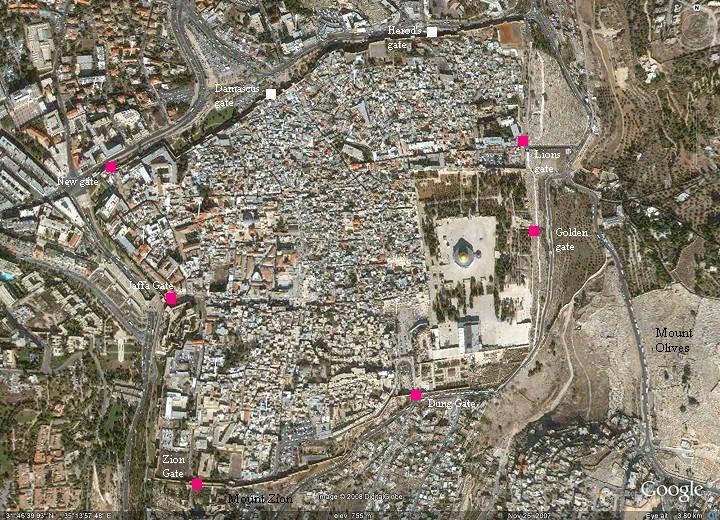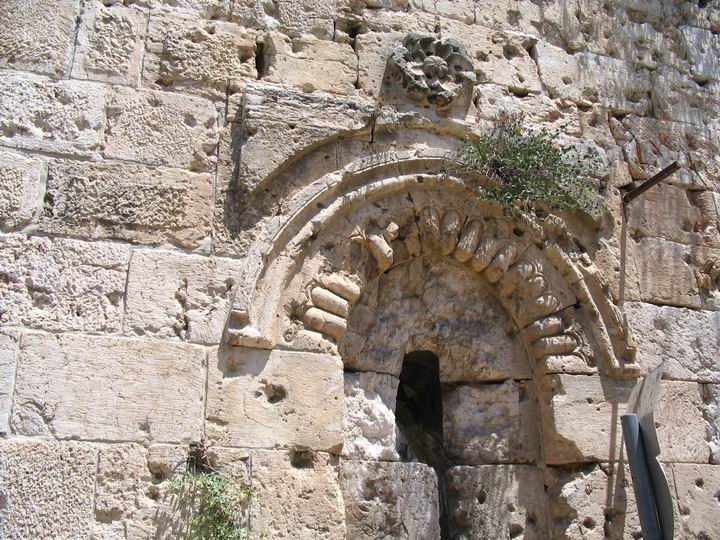The gate is located on the south-west side of the old city.
Home > Sites > Jerusalem > Mount Zion > Zion Gate
Contents:
Location
History
Photos
* Outside
* Inside
Biblical
Etymology
Location:
The Zion Gate is located on the south-west western side of the old city . It is one of the gates that lead to the Jewish and Armenian quarters.
Psalms 9:14: “That I may shew forth all thy praise in the gates of the daughter of Zion”
The aerial map shows the 8 gates of Jerusalem, with the Zion gate on the bottom (south side), facing Mount Zion. These are the gates, listed clockwise starting from the west corner:
1. New gate
2. Damascus gate (on the north-western side)
3. Herod’s gate (on the north side)
4. Lions’ gate (near St. Anna)
5. Golden gate (a closed gate, located south to the Lions gate)
6. Dung gate (on south side, near the western wall)
7. Zion gate (on the south-west side) – – – this site
8. Jaffa gate (tower of David)

History of the place:
The Ottomans built this gate in 1540 AD (947 according to Islam dates). A stone plate in the gate praises the builder, Sultan Süleyman Iben Salim. The gate was opened only during daytime, and was protected by guards. Due to its proximity to the Jewish quarter, the keys to the gate were also trusted to a Jewish member of the community. Hence its Arabic name – the gate of the Jews.

Zion gate – photo by P. Bergheim, 1860-1880 – Photos of the Library of Congress
During the independence war, in May 1948, Palmach forces combated the Jordanians at Zion gate and managed to reach the Jewish quarter which was under siege, but had to retreat and eventually the quarter was evacuated.
During the Jordanian occupation (1948-1967) the gate was closed. Today it is one of the main gates leading to the Jewish quarter.
In 2008 the gate started renovations. The works were completed in Sep 2008 (thanks for R. Munayer for his update).
Photos:
(a) Outside the walls:
A view of Zion gate from outside the walls. The entrance is “L” shaped in order to increase the security of the gate. Notice the numerous bullet holes, a result of the Israeli assault in May 1948 during the independence war to help to break off the siege of the Jewish quarter. This is why this gate is also named the “wounded” gate.
Click on the photo to view it in higher resolution…
A closer look in the left window, which is a decorated arrow slit.
A view from the street outside the old city, which is the walkway around the walls. On the right side are the walls of the Armenian church of the high priest Caiaphas.
(b) Inside the walls:
The photo below shows the view from inside the walls of the old city – the south side of the Armenian sector. A second floor is located above the gate, and incorporated in the walls. It was also equipped with defense installations, such as holes to pour boiling oil down on the attackers during a siege.
A closer look on the gate from the old city side. Notice the stone plate above the gate.
References:
Psalms 9:14:
“That I may shew forth all thy praise in the gates of the daughter of Zion: I will rejoice in thy salvation.”
Etymology (behind the name):
- Zion – As a place, Zion is the name of the hill where the Temple was built (Mount Zion). It later was one of the names of Jerusalem, and then extended to refer to the whole land of Israel. (Biblical text: Samuel II, 5: 7 “…David took the stronghold of Zion; the same is the city of David”).
- Bab El Nebi Daud – In Arabic, “the gate of the Prophet David”, one of the names of this gate.
- Bab Hart El Yahud – In Arabic, “the gate of the Jewish section”, an older name of the gate.
Links:
* Biblewalks:
- Mount Zion (overview)
- Armenian church – nearby “house of Caiphas”
BibleWalks.com – walk with us through the sites of the Holy Land
Jaffa Gate<—previous Jerusalem site–<<< All Sites >>>—next Jerusalem site–> Golden Gate
This page was last updated on Dec 26, 2020 (Added LOC photo)
Sponsored links:
